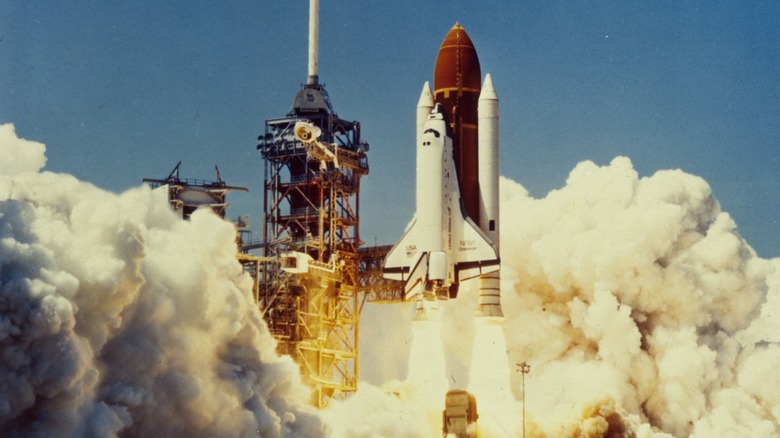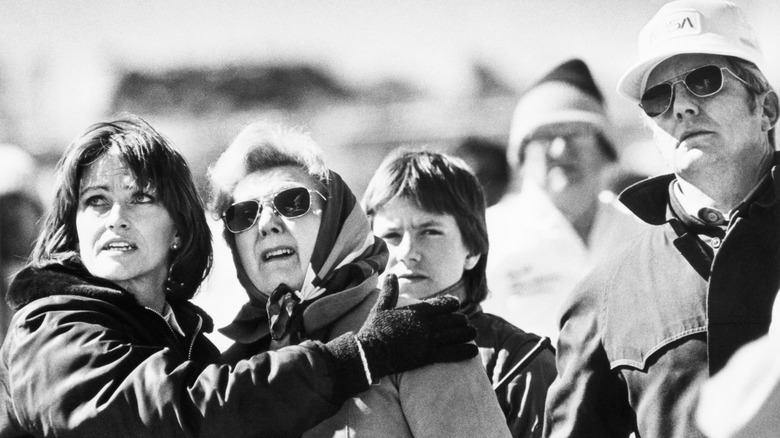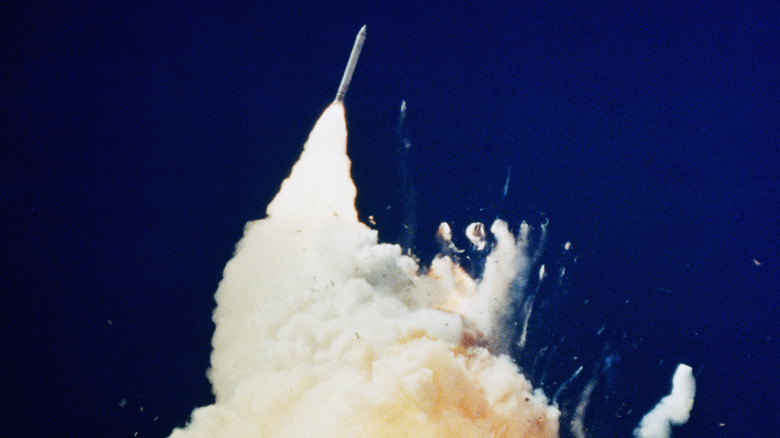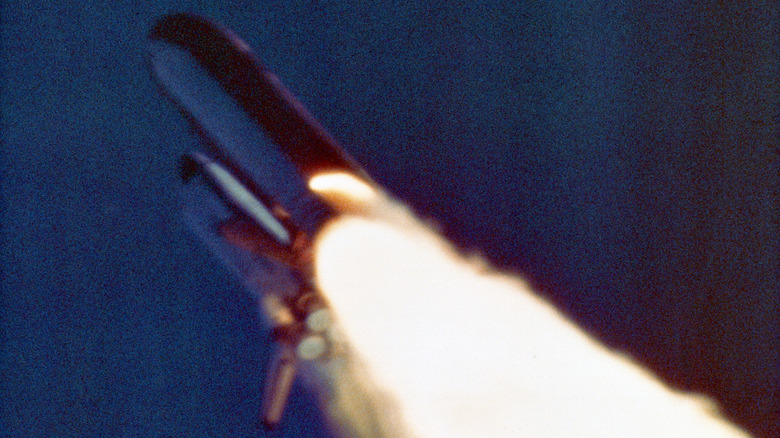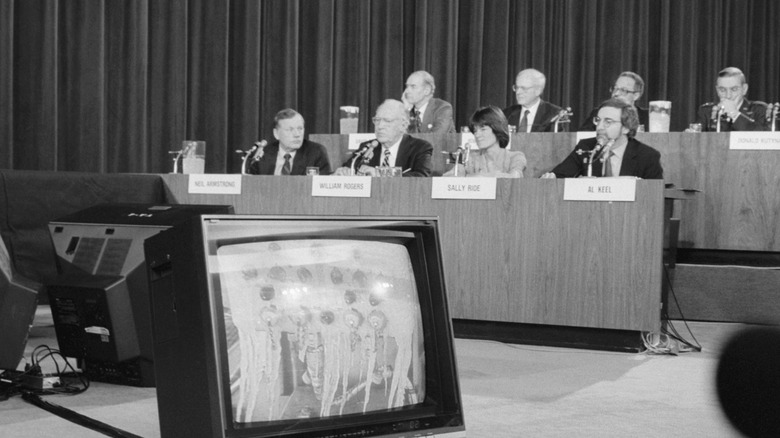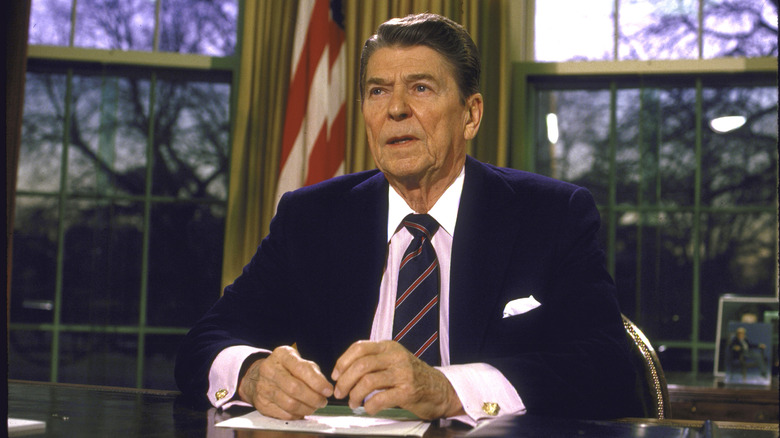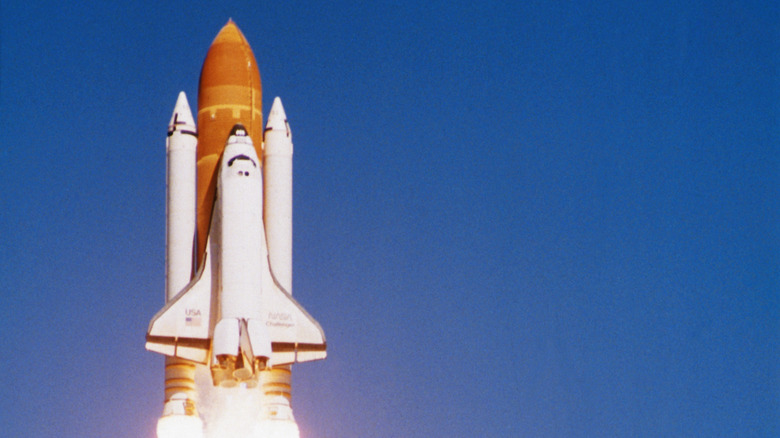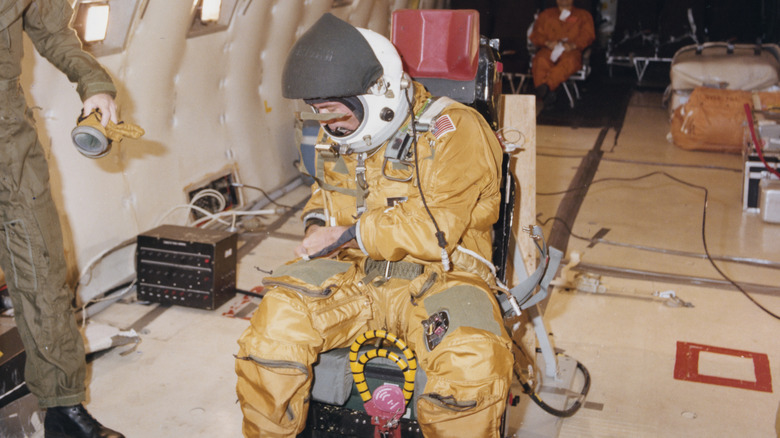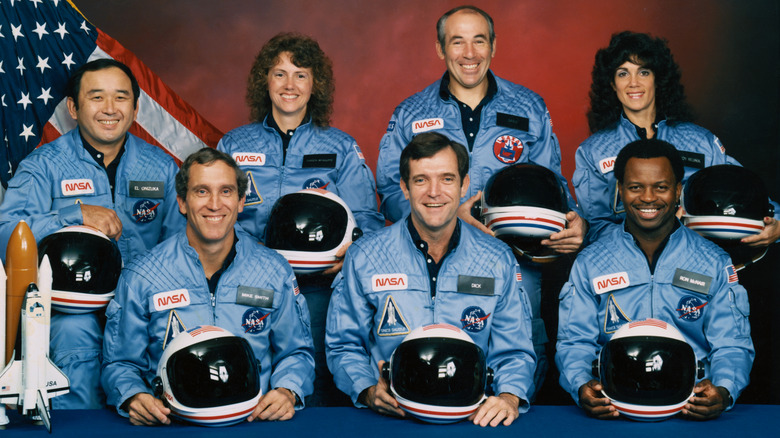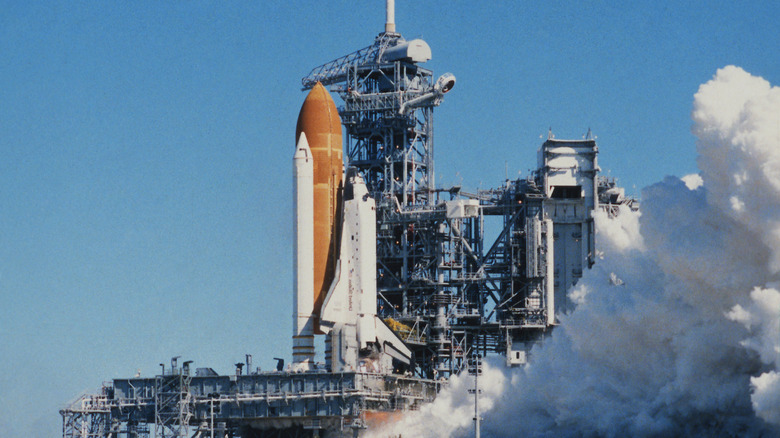Myths You Shouldn't Believe About The Challenger Disaster
It was a near-freezing morning at Kennedy Space Center on January 28, 1986. But, as far as just about everyone was concerned, that wasn't going to stop the launch of the space shuttle Challenger. With waiting scientific missions that had to be launched with the shuttle (including a study of the approaching Halley's Comet) and plenty of intensive training at their backs, seven astronauts entered the crew cabin of Challenger. These were Michael J. Smith, Dick Scobee, Ronald McNair, Ellison Onizuka, Christa McAuliffe, Gregory Jarvis, and Judith Resnik.
As the shuttle left the ground amid the roar of its engines, everything seemed to be fine. But just 73 seconds into the launch, when the shuttle was about 46,000 feet into the atmosphere, it was suddenly surrounded by a massive fireball and dramatically broke into pieces. Pilot Michael Smith's final recorded words — "uh-oh" — were the only indication that the astronauts knew something had gone awry. Parts of the shuttle may have reached as high as 65,000 feet before crashing into the Atlantic Ocean (where some parts of the shuttle remain today). No one on board survived.
The disaster was soon followed by an intensive investigation, which was summed up in the Rogers Commission report, as well as much media attention and a space administration that was never the same. Yet, as much as the Challenger disaster became a part of history, there still exist rumors and misconceptions about exactly what happened that cold morning.
A nation didn't necessarily watch it live
Many accounts of the disaster make it seem as if nearly everyone in the nation was watching the Challenger launch live, making the sudden loss of the shuttle all the more shocking as millions looked on in helpless horror. Yet, the reality is that few people were tuning in to the launch in real-time. Because Challenger launched shortly before noon Eastern time, most people were at work and couldn't sit in front of a television. Few networks were broadcasting the launch, anyway, making it all the more difficult for large swathes of the population to tune in.
That doesn't mean there weren't some live viewers. At the time, CNN was one of the only channels that bothered to set up a live feed of the launch, perhaps in part because it was a 24-hour news channel with a schedule to fill. A few others were able to take advantage of satellite broadcasts to see the launch, but the technology was new and not widely available.
However, NASA had arranged for some schools to show their students a live broadcast of the launch, meaning that a significant portion of those who witnessed the Challenger disaster in real-time were shocked schoolchildren. Those included at least some of the New Hampshire-based students of Christa McAuliffe, the high school social studies teacher who was among the seven astronauts and who was set to be the first teacher in space.
The astronauts possibly didn't die right away
Looking at the tremendous physical damage that occurred shortly after takeoff, many assumed that the seven astronauts inside the Challenger at least met their ends quickly. However, the shuttle itself didn't break up immediately after the fuel tanks failed. It only did so as it moved uncontrolled through the atmosphere. At that point, the crew cabin remained intact, likely carrying still-living astronauts as it began to fall back towards Earth.
Whether or not the Challenger crew remained conscious isn't entirely known. It's likely that the crew cabin, which was about 65,000 feet up when it started to descend, lost pressure. Deprived of oxygen, the astronauts would have lost consciousness fairly quickly, even with the personal egress air packs (PEAPs) that contained emergency air. However, a 1986 report from NASA biomedical specialist Joseph P. Kerwin noted that, during the recovery process, it was found that at least three astronaut PEAPs had been activated, which can only happen manually.
This indicates that some on Challenger had stayed conscious just long enough to turn on the PEAPs of their fellow astronauts. These likely included Judith Resnik or Ellison Onizuka, who appear to have activated the PEAP of shuttle pilot Mike Smith. As astronaut Mike Mullane wrote in "Riding Rockets," "There had been nothing in our training concerning the activation of a PEAP in the event of an in-flight emergency. The fact that Judy or El had done so for Mike Smith made them heroic in my mind."
The shuttle didn't really explode
Viewing the footage of the Challenger disaster, it's easy to conclude that the shuttle exploded. There is a large fireball quickly followed by the disintegration of the rocket and shuttle. But a closer look at the evidence shows that the breakup technically wasn't an explosion at all.
Essentially, the root cause of the disaster was a fuel leak in the shuttle's right solid fuel rocket booster. During the launch, that escaping fuel caught fire, weakening connections between the booster and the large liquid fuel rocket. Eventually, the booster broke loose, swung around, and pierced the liquid fuel tank, releasing liquid oxygen. The liquid hydrogen fuel tank had also already been compromised by the fire and had begun to leak as well. When the two fuels mixed, they ignited and created the large fireball seen in the footage. However, the boosters actually survived this catastrophic failure and continued flying on their own until NASA officials remotely detonated them over the Atlantic.
The shuttle also survived the fireball — for a short while, anyway. It continued flying for a moment but, soon after breaking away from the fuel tanks, the aerodynamic forces acting upon it tore the craft apart. Ultimately, though the fireball and subsequent breakup were dramatic and catastrophic, it had few of the auditory or physical effects of an explosion, such as a shockwave or loud noise. Instead, those on the ground likely heard something more chilling: silence as the rockets cut out.
The disaster didn't surprise everyone at NASA
Though onlookers to the launch were shocked, at least some at NASA knew that something could go wrong. An official investigation found that the fuel leak had been caused by faulty O-rings manufactured by Morton Thiokol. The O-rings were meant to seal joints in the solid fuel rocket boosters; their failure meant that fuel leaked and ignited during the launch.
Less than a day before the launch, engineers at Morton Thiokol raised serious concerns about the O-rings. The main issue, they said, was the unusually cold temperatures predicted for the next morning. At the time of Challenger's 11:38 a.m. launch, it was only 36 degrees Fahrenheit. However, the O-rings that helped to seal the joints in the rocket boosters were rated to fly at a minimum of 39 degrees or higher. Morton Thiokol engineers knew this and frantically urged their managers and NASA officials to delay the launch.
Yet, after multiple delays in the shuttle program, NASA was anxious to move forward with the launch, and the engineers' concerns were overruled. Despairing, engineer Bob Ebeling told his wife Darlene, "It's going to blow up" (via NPR). Fellow Morton Thiokol engineer Allan McDonald, who oversaw the booster rocket construction process for the contractor, refused to sign off on the launch and later brought attention to NASA officials' attempts to cover up important details — like how they had pushed Morton Thiokol managers to approve the boosters despite evidence from engineers that disaster loomed.
A rocket sealant issue wasn't the result of an asbestos ban
Some examinations of the Challenger disaster point not just to faulty O-rings in the rocket boosters, but also to issues with the putty used to help seal those joints. Moreover, some have gone so far as to blame an environmental push for the disaster, saying that a move away from heat-resistant asbestos putty was a contributing factor to the failure. But, while the putty sealant had been replaced, that was done before any such regulatory change came into effect. In fact, the replacement putty also included asbestos. Some sources claim that the new sealant's asbestos came in the form of longer, thicker fibers that may have weakened the sealing properties of the putty. However, it's not clear that this was a major factor in the joint failure.
What may have been a more serious issue were the tests that NASA conducted on those joints. According to the Rogers Commission Report issued by post-disaster investigators, engineers had suggested the joint leak checks forced air through the putty and O-rings, creating blow holes in the putty that may have weakened the joint. Ultimately, however, whether or not the putty contained the right kind of asbestos likely didn't matter. Investigators concluded that the source of the disaster wasn't in the putty, but the cold-affected O-ring seal.
The Reagan administration didn't rush the launch
Looking at first-hand accounts of the Challenger disaster, it's clear that NASA officials were anxious to move the launch forward. But who was behind that anxiety? Some sources have pointed to the Reagan administration, claiming that the president wanted the launch to happen before the upcoming State of the Union address so he could have a cool mid-speech call with the astronauts. Shortly after the disaster, White House spokesperson Larry Speakes said that it was "the most vicious and distorted rumor I have ever heard" (via Los Angeles Times). Indeed, President Ronald Reagan delayed the State of the Union by one week, the first time it had been postponed. Instead, he spoke directly to the nation about the disaster on the evening of January 28.
If the pressure wasn't coming from Reagan and his staff members, then where did it originate? It may well have been from inside NASA itself. It had been combating flagging interest in the space program, poor internal and external communication practices, and general frustration stemming from previous (and expensive) launch delays. When Lawrence B. Mulloy, then the manager of the solid rocket booster program at NASA, was confronted with the push to delay Challenger over concerns about the booster's O-rings, he reportedly exclaimed "When the hell do you want me to launch, next April?" (via The New York Times).
The main engines did not malfunction
Lost in the confusion of the disaster and the highly technical investigation that followed, you may think something went wrong with the shuttle itself. After all, Challenger, like all the other space shuttles, had main engines on the craft in addition to the rocket boosters meant to get it into orbit. Those main engines used liquid oxygen and liquid hydrogen, which were mixed to combust and provide power (along with plenty of water vapor).
However, the truth is that the Challenger shuttle worked fairly well. For a brief moment or two after the fuel rockets catastrophically failed, it continued flying on its own, though the intense physics of its high-speed uncontrolled flight through the atmosphere soon caused it to break apart. If the astronauts had somehow been warned of the issues, the shuttle would have theoretically been able to detach from the rockets and return to Earth as a glider under minimal power.
Ultimately, the Rogers Commission found that the shuttle's main engines had nothing to do with the accident. NASA continued using the engines for later launches and remains so confident in the main engine design — more broadly known as the RS-25 engine — that it's using it as part of the next phase of its rocket missions. This includes its use in the Space Launch System (SLS) meant to send the Artemis rocket to the moon, as well as kicking off deep space missions further into the solar system.
The disaster did not lead to shuttle ejection seats
Part of the truth of the Challenger disaster is that, once the shuttle had launched, there was little chance of escape. According to the Rogers Report, early on in the shuttle program, a thrust termination procedure was considered. This would have allowed for the rocket boosters to stop firing mid-flight, allowing crewmembers to evacuate the vehicle. Yet, this proved a tricky concept. The aerodynamic forces that bore down on a shuttle mid-launch were nothing to laugh at, and NASA engineers concluded that reinforcing the shuttle for a mid-launch abort procedure would have added more than 19,000 pounds to the vehicle. The idea was largely out of consideration by 1973 and certainly was not part of the plan in 1986. In short, once Challenger had begun to launch, there was no turning back.
In the aftermath of the disaster, this notion was revisited, but quickly discarded in favor of a mid-flight escape maneuver that would have astronauts bailing out of a side hatch and then parachuting off a telescoping pole (this would only work if the shuttle was horizontal, below 20,000 feet in altitude, and in controlled flight). Ejection seats were impractical in the shuttle's two-floor crew cabin, while similar rocket-powered techniques sometimes tore test dummies to pieces. While the bail-out plan was tested by Navy personnel and astronauts were trained to complete it, the maneuver was never needed and certainly wouldn't have helped the Challenger astronauts once things had gone wrong.
Some conspiracy theorists believe the astronauts were never on the shuttle
Perhaps the most ridiculous myth surrounding the Challenger disaster is the idea that at least some of the seven astronauts aboard managed to survive. Or, rather, that they never got on the shuttle in the first place, knowing that they were taking part in a murky conspiracy meant to control the public via a dramatic and media-ready disaster.
As the general idea goes, the disaster, watched live by some schoolchildren, was orchestrated to traumatize young people and make them more compliant. Of course, trauma reactions are highly individual. The evidence is pretty shaky, too, including claims that living professionals and academics are the surviving astronauts. If so, they're not doing a good job at keeping it on the down-low. For instance, why would astronaut Judith Resnik fake her death and take on a new life as ... a high-profile Yale academic named Judith Resnik? Similarly, the theory that Ellison Onizuka took on the persona of his brother, Claude, generates a new mystery as to where the heck the original Claude went. At any rate, a careful look at the details associated with the genuine astronauts and their supposed doubles shows multiple discrepancies in basics like graduation dates and physical appearances.
Unfortunately, it's far more plausible that all the Challenger astronauts died in the 1986 disaster. According to multiple accounts, their bodies were recovered from the Atlantic and buried in either individual plots or at Arlington National Cemetery.
Cold wasn't the only issue leading to the Challenger disaster
Cold weather was rightfully considered a major factor in the Challenger disaster. The rubber O-ring that joined a section of the shuttle solid rocket booster had become less flexible in the close-to-freezing temperatures that morning, leading to the fuel leak and fireball that abruptly ended the mission.
However, putting all of the blame on low temperatures doesn't present the fullest picture of the Challenger disaster. Issues with the O-rings had already been known to officials and were observed after launches on higher-temperature days. Furthermore, investigators suggested that the rocket section joints had further issues, including a sealant putty that may have contained enough air holes (ironically introduced via leak check testing) that could have directed heat and fuel towards the O-rings, damaging them further.
But perhaps the largest problem of all wasn't the result of cold-hardened O-rings or faulty putty, but an inflexible decision-making process. NASA officials were clearly anxious to go forward with the launch, pushed along by the desire to deploy scientific equipment at the right time, avoid expensive delays (estimated in 1986 at $300,000 for every scrubbed launch), and recapture flagging public interest in the nation's space program. Some have also suggested that Christa McAuliffe's teaching schedule played a role; she was set to teach on the fourth day of the mission, meaning a delayed launch would have had her teaching on the weekend when no children would have been in school.
